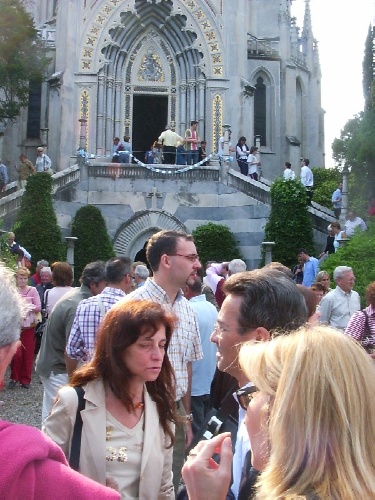Contenuto
Percorso : HOME > English > Cassago BrianzaCASSAGO BRIANZA

The Mausoleum of the Viscount in the Saj˛pp feast-day
Cassago Brianzaá
Cassago Brianza, or rus Cassiciacum as it was called by St. Augustine, is today a green village in the centre of Brianza. Inhabited by Gallic tribes, the village experienced the presence of the Romans.
The Gallic and Roman archaeological treasures of Cassago had already been reknown since the late 1500s, but the 3000-year-old history of this village where St. Augustine lived is mainly due to the 20th century excavations and some occasional discoveries. The oldest archaeological findings (macroliths and microliths) date back to the Neolithic Era.
The Romans or the romanised natives, amongst whom there may have been someone called either Cassius or Cassicius from whom the present place name is derived, probably occupied Cassago. Here also is the site of the rus Cassiciacum of Verecundus, who gave hospitality to St. Augustin during 386-387 A. D. It is here too that a certain MARILLA lived, while another inscription mentions an unknown person.
After the Romans, came the Lombards, and Cassago came into the possession of some warriors and their descendants were still present in the area in 854.
In the Middle Ages it also experienced the Longobards and some monks who founded the church of S. Brigida d’Irlanda. During that period the village and the surrounding countryside were owned by the monasteries of Civate, Pontida and Cremella and by the Church of S. Giovanni in Monza.
Since 1500 A.D. the noble family Pirovano occupied the medieval fort and the castle; in the 1700s they were followed by the Modroni family and the Visconti Dukes. During the XVIII century the castle's vast property or “the estates of the tower” were inherited by the Viscontis of Modrone. On the Unification of Italy, two separate municipalities were formed: Cassago and Oriano remained autonomous until 1929, when they were put together again to create the original territorial unit.
A passage from the Chronicon of the parish of Cassago says that in 1630 the village was not touched by the plague. This was attributed to St. Augustine’s intercession. This was the reason why the people proclaimed him their Patron Saint and since 1631 onwards he’s been celebrated every year. The text states: "Et cum moris christiani sit memoriam habere beneficiorum acceptorum, illaque attribuere alicui Sancto protectori, ideo Communitas ista Casagi non immemor tantae gratiae ultra predictos, ut supra Patronos, adjungit sibi et supplicat auxilium beatissimi AUGUSTINI Pontificis Hipon. Et Doctoris Sanctae Ecclesiae eximii; eoque magis cum memoriae proditum sit ipsum Sanctum patrios lares habitasse".
In 1700 a chapel dedicated to the Saint was built inside the parish church. Since 1800 a folk devotion has been known, developed near the fountain of St. Augustine.

